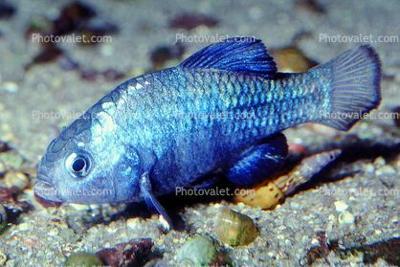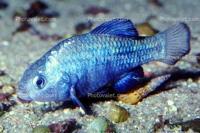Imperial Irrigation District had planned a conservation program with Valley farmers in April to meet promised obligations with Colorado River draws, scaling back again from its priority allotment of 3.1 million acre-feet.
IID General Manager Jamie Asbury told the AP that those plans won't start until at least June so water and wildlife officials can devise a way to ensure the endangered desert pupfish and other species are protected.
The proposal to pay farmers to temporarily stop watering feed crops such as alfalfa this summer has environmentalists concerned that irrigation drains could dry up, threatening the fish that measures the length of an ATM card, according to a report from Patch.
"Drains are created for farmers to be able to convey irrigation runoff, and the pupfish decided it was a good place to live," Asbury said in the Patch article.
Protecting the desert pupfish, listed as endangered since 1986, has been one of many vexing problems facing the Colorado River and the people and species that rely on it.
The almost 1500-mile meandering river provides water to 40 million people in seven U.S. states, parts of Mexico, and more than two dozen Native American tribes. As the drought continues, the river currently lacks the flow to deliver its total allotment. The federal government, mainly through the Bureau of Reclamation, has put pressure on the senior water rights holders to share in the junior rights holders’ cutbacks. The Western states are negotiating a new long-term use plan meant to stabilize the river.
Last year, Arizona, Nevada and California offered to cut back on their use of Colorado River water in exchange for money from the federal government to avoid forced cuts. California, which gets the most water of all the states based on a century-old water rights priority system, agreed to give up 1.6 million acre-feet of water through 2026, with more than half coming from the Imperial Irrigation District. The 2007 Interim Guidelines Colorado River stakeholders have been following will end in 2026, so duo negotiations are ongoing to tweak the guidelines they are presently following and an agreement to replace the soon-to-end contract regarding water supply and reservoir operating decisions. An acre-foot serves about two to three U.S. households per year.
The IID planned a summer idling program in which farmers could turn off water for 60 days for feed crops since yields already are down due to high temperatures and growing requires much more water. But environmental officials worried that limiting the flow of water through irrigation drains could harm the desert pupfish. They also raised concerns about the impact on migratory birds that frequent the Salton Sea, Asbury said.
The IID with more than 3,000 miles of canals and drains is in talks with state and federal officials on how it can proceed while setting up a monitoring program to ensure the fish isn't further threatened, Asbury said in the Patch article.
The desert pupfish is a small, rare species of bony fish. A notable attribute of the desert pupfish is their ability to survive in environments of extreme salinity, pH, and temperature, and low oxygen content. The once plentiful fish has declined in numbers with the introduction of invasive species in the Colorado River according to California's Department of Fish and Wildlife.
Presently it lives in a few areas in California, Arizona and Mexico, including the Imperial Irrigation District's drains.
Often, the district's drains have more fresh water than the Salton Sea, so the fish seek out those spaces, said Ileene Anderson, senior scientist with the Center for Biological Diversity.
"A lot of them do live in these really bizarre drains, these agricultural drains," she said in the Patch article. "These fish are incredibly tough, they basically just try to find a space where they can carry on their lives."
The desert pupfish is a key part of the ecosystem in the Salton Sea, feeding on biting flies and serving as a food source for birds, said James Danoff-Burg, vice president of conservation at the Palm Desert-based Living Desert Zoo and Gardens, which works on desert conservation. In the summer, creeks that flow into the Salton Sea can dry out so much the fish risk getting stranded, so they are moved to special ponds as an insurance population, he said.
California's Department of Fish and Wildlife declined to discuss the water conservation plan. The department said in an emailed statement that officials support water use reductions on the Colorado River and will work with other agencies to "find solutions that proactively minimize and mitigate any potential impacts to the great work underway."
The Bureau of Reclamation, which operates major dams in the Colorado River system, did not immediately comment.
Environmentalists have long said that while many species depend on the Colorado River, decisions about how to use its water typically focus on human needs, not wildlife.



























(0) comments
Welcome to the discussion.
Log In
Keep it Clean. Please avoid obscene, vulgar, lewd, racist or sexually-oriented language.
PLEASE TURN OFF YOUR CAPS LOCK.
Don't Threaten. Threats of harming another person will not be tolerated.
Be Truthful. Don't knowingly lie about anyone or anything.
Be Nice. No racism, sexism or any sort of -ism that is degrading to another person.
Be Proactive. Use the 'Report' link on each comment to let us know of abusive posts.
Share with Us. We'd love to hear eyewitness accounts, the history behind an article.